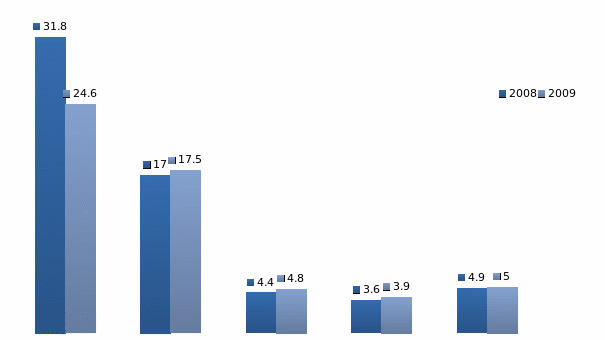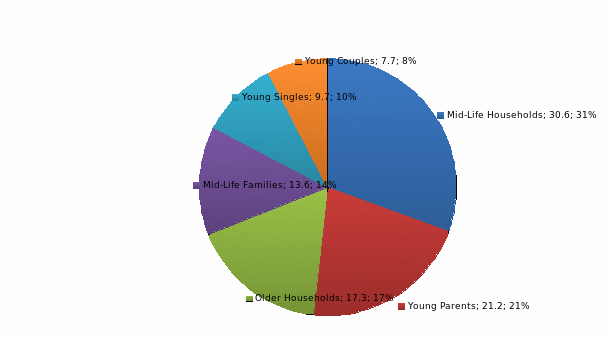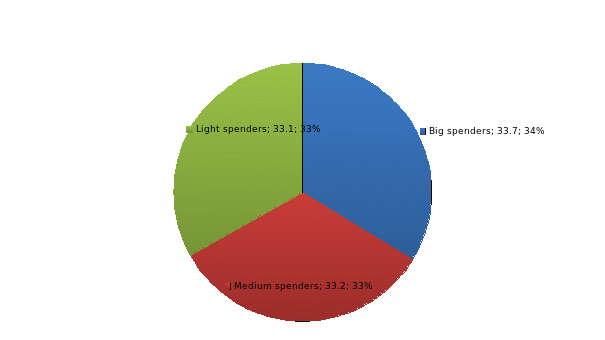Introduction
Tourism Tasmania received a boost as it was believed that the industry is expected to achieve a boost (ECOS, 2005). Experience tourism is the new strategy that has been undertaken for development of tourism in Tasmania (Tourism Tasmania, 2010a). The main aim of the Tasmanian Experience strategy for tourism is “… to integrate Tasmania’s three core visitor appeals of place, infrastructure and service, to create unforgettable holiday experiences by focusing on presentation, interpretation and customer engagement.” (Tourism Tasmania, 2010a). The question that arises is if this strategy is a viable option for sustainable development. In 2009, there was an increase in tourist expenditure in the region by only 0.6% in 2009 as compared to 2008 expenditures. Where, the rate of increase in expenditure in 2007 was 6% and in 2008 was 11% (Tourism Tasmania, 2010b). As there has been a fall in the growth of tourist expenditure in the region, an attempt must be made to understand the sustainability and success of the present total experience strategy employed by Tasmania tourism.
Destination branding is one of the most viable and best marketing tools available to the tourism industry (Morgan & Pritchard, 2002). However, one challenge with this form of branding is that most tourists are looking for lifestyle experience rather than niche travel experience (Morgan & Pritchard, 2002). Different elements of tourism are presented in destination branding like culture, landscape, heritage, etc. total experience would imply that all these are clubbed under one roof. Therefore, is it a good strategy for Tasmania? The aim of the paper is to understand if the strategy employed for Tasmanian tourism is a viable and sustainable approach or not. Further, if there are any problems associated with it, what are these problems? The two research questions that are addressed in the paper are – (1) how does Tourism Tasmania’s experience product strategy illustrate the characteristics of successful destination branding and (2) what are some of the problems that might arise in delivering on the brand promise?
Destination Branding and Total Experience Strategy
Destination is the area that tourists choose to visit. It is a “spatial or geographical concept that is primarily defined by visitors from outside the location” chosen to visit for different reasons (Cooper & Hall, 2008, p.112). A tourist destination has been defined by Harrill (2009, p.449) as “a country, a region, an area, or a local habitation”. Thus, the destination assumes the place of the product and it is branded in order to attract more visitors (customers).
Destination marketing is considered to be an amalgamation of tourism services and experience (Buhalis, 2000). Therefore, Buhalis emphasizes a destination more of a conceptual concept than a space or area. Branding of destination first consists of creation of a set of images in the mind of the prospective visitors through advertisements, promotions, travel brochures, etc. then when they visit the destination, those images will be affected or re-created based on the first-hand information and experience (Echtner & Ritchie, 2003). Therefore, one of the key strategies for destination marketing is to create a viable image of the destination and back it up during first hand experience. Development and economic growth are usually associated with proper tourism planning and implementation (Brenner, 2005). The tourism planning theory was marked with usual euphoria about economic growth and technological advances due to destination tourism development. However, “lack of infrastructure and domestic capital” cause greatest hindrances to tourism-based growth (Brenner, 2005, p.140). Thus, not all tourism destination-marketing strategies are successful. Therefore, how can the success of the strategy be determined? Buhalis (2000, p.98) mentions a Six As framework to analyse a tourism destination strategy, which are attractions, accessibility, amenities, available packages, activities, and ancillary services. Further he states that in order to make a destination marketing strategy successful, it is important to generate “satisfaction among interacting tourists and hosts, it must adopt societal marketing strategies” (Buhalis, 2000, p.98).
Experience marketing in tourism is discussed by (Haahti & Komppula, 2006) who posits that visitor experience can be judged through two dimensions –
“1. The extent of participation by the customer/guest (which may vary from active to passive) 2. The emotional mode and extent of involvement in the experience (which varies from immersion to absorption). The second dimension anchors the experiences deeply in the realm of emotions and feelings” (Haahti & Komppula, 2006, p.102). Therefore, the important aspect of experience marketing, according to Haahti and Komppula, is to enable the visitor to go through an emotional and intellectual revelation in order to have a lasting influence on the tourists. Thus, when a tourist destination employs an experience strategy, a complete evaluation of the outcome must be undertaken in order to understand if the strategy is working efficiently. For this purpose, this paper investigates the total experience strategy undertaken by Tasmania Tourism.
Tasmania’s Total Experience Strategy
The Tasmanian Experience strategy’s aim is to integrate the 3 main mares of Tasmanian tourism and appeal to customer experience (Tasmania Tourism, 2010c). The aim of the strategy is to put Tasmania into the “pre-eminent position in customer’s minds” (Tasmania Tourism, 2010c, p.1). In this section, a brief of the strategy is presented.
The strategies, identified by Tourism 21, have presented five main strategies that will be undertaken as the enhancer of the experience strategy. Presently the Tasmanian tourism fetches more than $1 billion in terms of tourist expenditure annually. The aim of the strategy was to increase visitor expenditure by getting the tourists more engaged in order to make higher yields. The core appeals of the tourism strategy are Tasmanian culture, wine and food, heritage, and nature. However, the tourism board identifies that these are not unique offerings to the customers. However, the main aim of the policy makers is to attract high spending holidaymakers. This is a potential problem as other destination marketers also target this segment. Further, there exists an extensive gap in the visitors want and what Tasmania has to offer (Tasmania Tourism, 2010c). The customer perception study conducted by Tasmania Tourism in 2005 shows that for interstate travellers the main issue for choosing Tasmania and its various destinations are accessibility (Tourism Tasmania, 2010a). Another issue identified is the overlap of offerings from different locations within Tasmania is another problem (Tourism Tasmania, 2010a). Another barrier to holidaying in Tasmania is the awareness of the variety of offerings that the state has (Tourism Tasmania, 2010a).
The marketing branding operations done by the strategy makers in Tasmania are related to branding exercises done by the strategy makers. The brand that has been promoted so far is “A world apart, not a world away” (Tourism Tasmania, 2010a). The experience marketing promotes excellent destination, lifestyle offerings like accommodations and trying to attract more domestic travellers. Tasmania has tried to attract visitors through sports, festivals, and special groups like gays (Tourism Tasmania, 2010a).
An evaluation of the total experience strategy is done in the following sections. First, the paper evaluates the advertising performance of tourism in Tasmania. Based on overall data, the advertisement that may have prompted visitors to come to the state is presented in figure 1. The diagram shows that the future desire of the visitors to come back to Tasmania which has been prompted by promotions and advertisements had gone down in 2009 as compared to 2008. Advertisement awareness of Tasmanian tourism and its offerings had reduced from 31.8% in 2008 to 24.6% in 2009. There has only been a marginal increase in the Nett trip preference, intention, and intention in 12 months for Tasmania. Further, there was a decline in the unprompted advertisement awareness of visitors from 16.6% in 2008 to 15.7% in 2009 (Toursim Tasmania, 2010b). Report on Tasmanian tourism shows that there has been an increase in total visitors to Tasmania by 2% in 2009. Visitors’ expenditure survey shows that there has been a fall in the expenditure of the top five reasons from 2008 to 2009. The reason for which visitors mostly came to Tasmania is holidaying. However, expenditure fell from $1,058,367 in 2008 to $ 993713 in 2009. Therefore, tourism strategy in Tasmania should target the customers who visit for holidaying.




Tourism strategy in Tasmania targets heavy spenders. This strategy is wrong as the data from the visitors’ survey in Tasmania shows that the people who visit to Tasmania, their spending pattern across three categories i.e. big spenders, medium, and small spenders is uniformly divided (see figure 3). Further, the visitors who come to Tasmania are mostly families as total families (see figure 4). 30% of those who visits belong to mid-life households, while 21% are young parents, 17% are older households, and 14% mid-life families. Targeting of the customers must be in a better way and in accordance to their preference of location for holidaying. Tasmania’s experience strategy is based on drawing customers who spend the most – “Destinations that draw visitors who spend most on holidays today promise and deliver exceptional and unforgettable experiences.” (Tasmania Tourism, 2010c, p.4) However, the customers who visit Tasmania comprise of 33% light spenders, 33% medium spenders, and 34% big spenders. Therefore, in order to attract the largest amount of crowd, it is important to target all spending categories and not only the niche 34%.
Conclusion
The experience strategy employed for Tasmanian tourism is an appropriate way of marketing the brand. However, the problems that are observable in case of the marketing strategy are the gap in planning and implementation. The strategy planners have laid down a comprehensive plan to attract customers; however, the implementation stage does not match with the offerings. Advertisements and promotions do not reach the customers properly who are not at all induced by these marketing tools to visit Tasmania. As the internet has been identified by the survey as the choice of media for information, it must be marketed to the customers through this means. An overview of the Tasmanian tourism survey shows that there has been an increase in travellers into the state since 2001, and mostly there has been an increase in leisure travellers, which comprises the largest part of the total travellers. Therefore, the Tasmanian marketing strategy must try to target these customers and find out the areas that they prefer to visit and what media preference they have for promotional activities.
Reference List
Brenner, L., 2005. State-Planned Tourism Destinations: The Case of Huatulco, Mexico. Tourism Geographies , 7(2), p.138–164.
Buhalis, D., 2000. Marketing the competitive destination of the future. Tourism Management, 21(1), pp.97-116.
Cooper, C. & Hall, C.M., 2008. Contemporary Tourism: An International Approach. Burlington, MA: Butterworth-Heinemann.
Echtner, C.M. & Ritchie, J.R.B., 2003. The Meaning and Measurement of Destination Image. The Journal of Tourism Studies, 14(1), pp.37-48.
ECOS, 2005. Tasmania’s tourism future brightens. Web.
Haahti, A. & Komppula, R., 2006. Experience design in tourism. In D. Buhalis & C. Costa, eds. Tourism business frontiers: consumers, products and industry. Burlington, MA: Butterworth-Heinemann. pp.101-10.
Harrill, R., 2009. Destination Management: New Challenges, New Needs. In M. Robinson & T. Jamal, eds. The SAGE Handbook of Tourism Studies By. London: Sage. pp.448-63.
Morgan, N. & Pritchard, A., 2002. Meet the Destination Branding Challenge. In N. Morgan, A. Pritchard & R. Pride, eds. Destination branding: creating the unique destination proposition. Birlington, MA: Butterworth-Heinemann. pp.59-78.
Tasmania Tourism, 2010. The Tasmanian Experience. Web.
Tourism Tasmania, 2010. Tourism Tasmania Corporate. Web.
Toursim Tasmania, 2010. Tourism Tasmania’s Online Survey Reporting Tool. Web.
